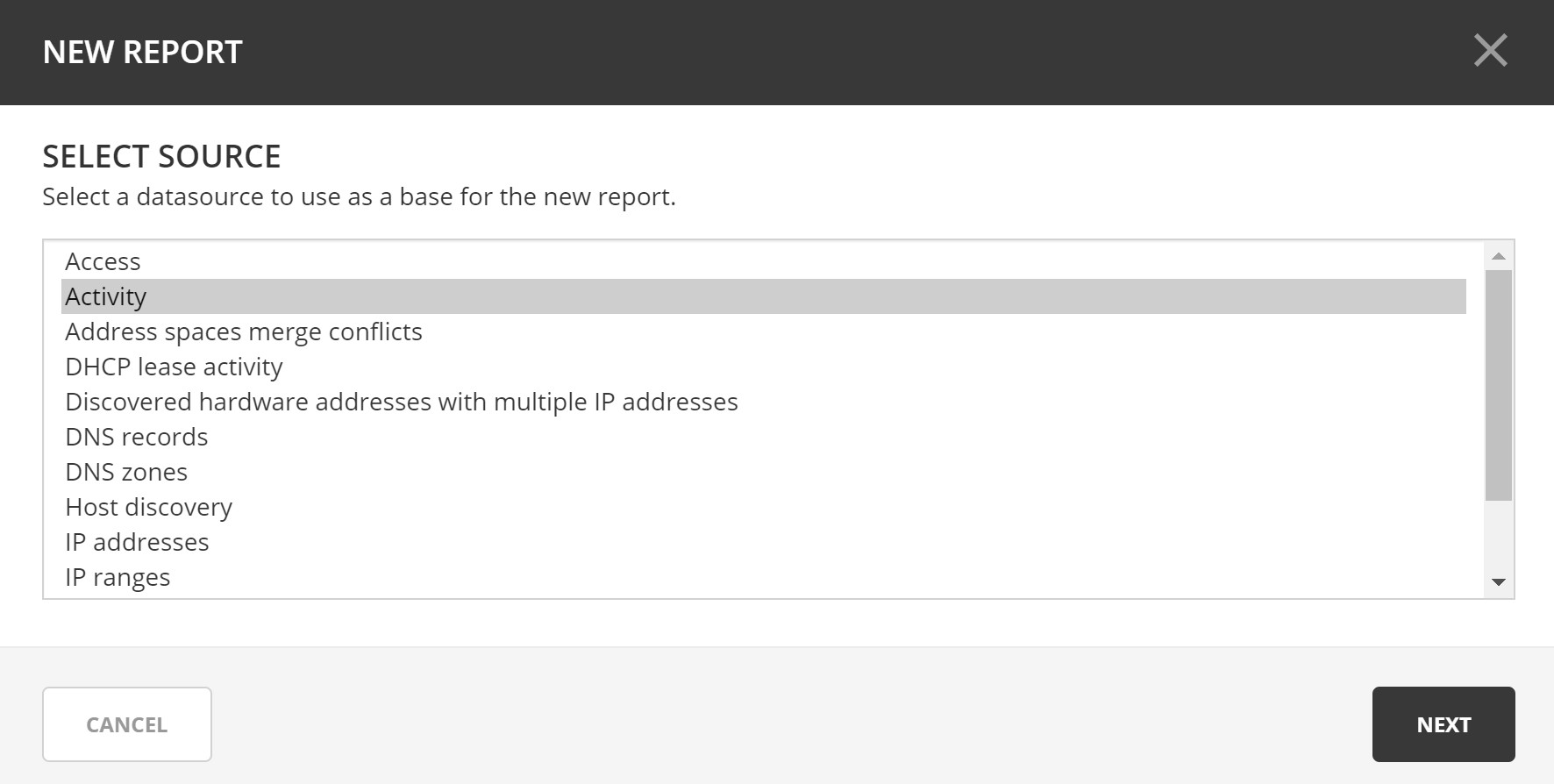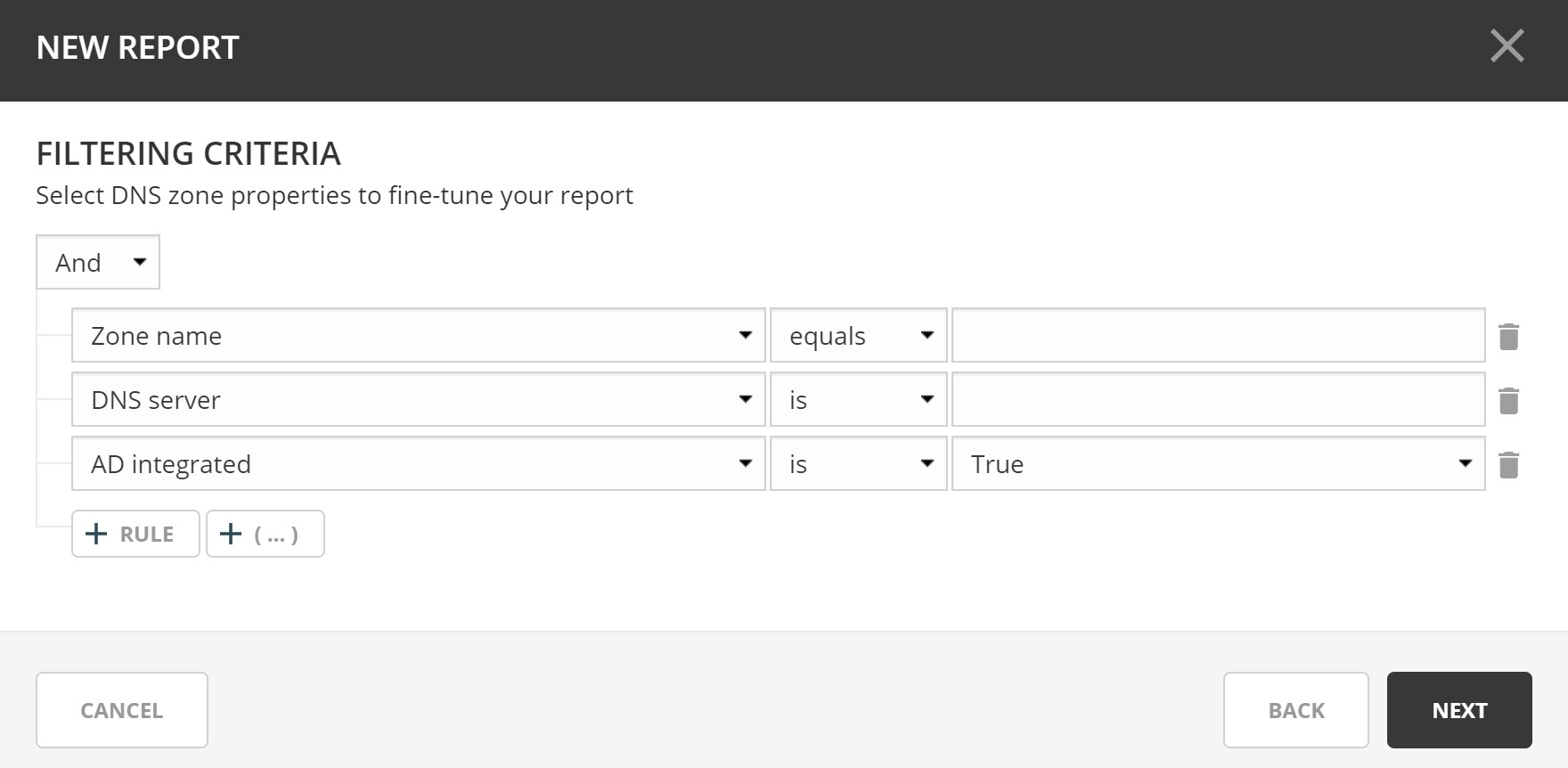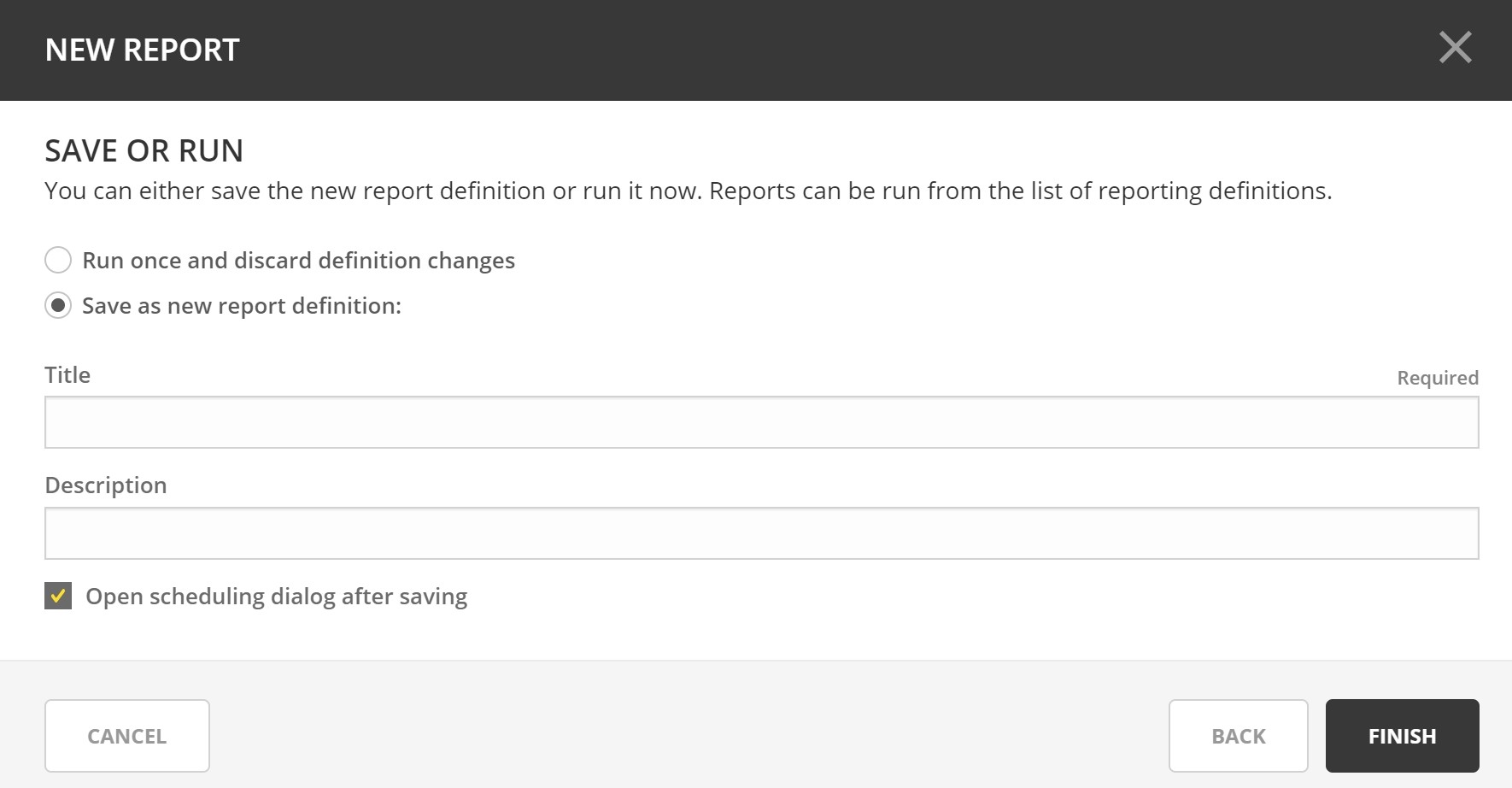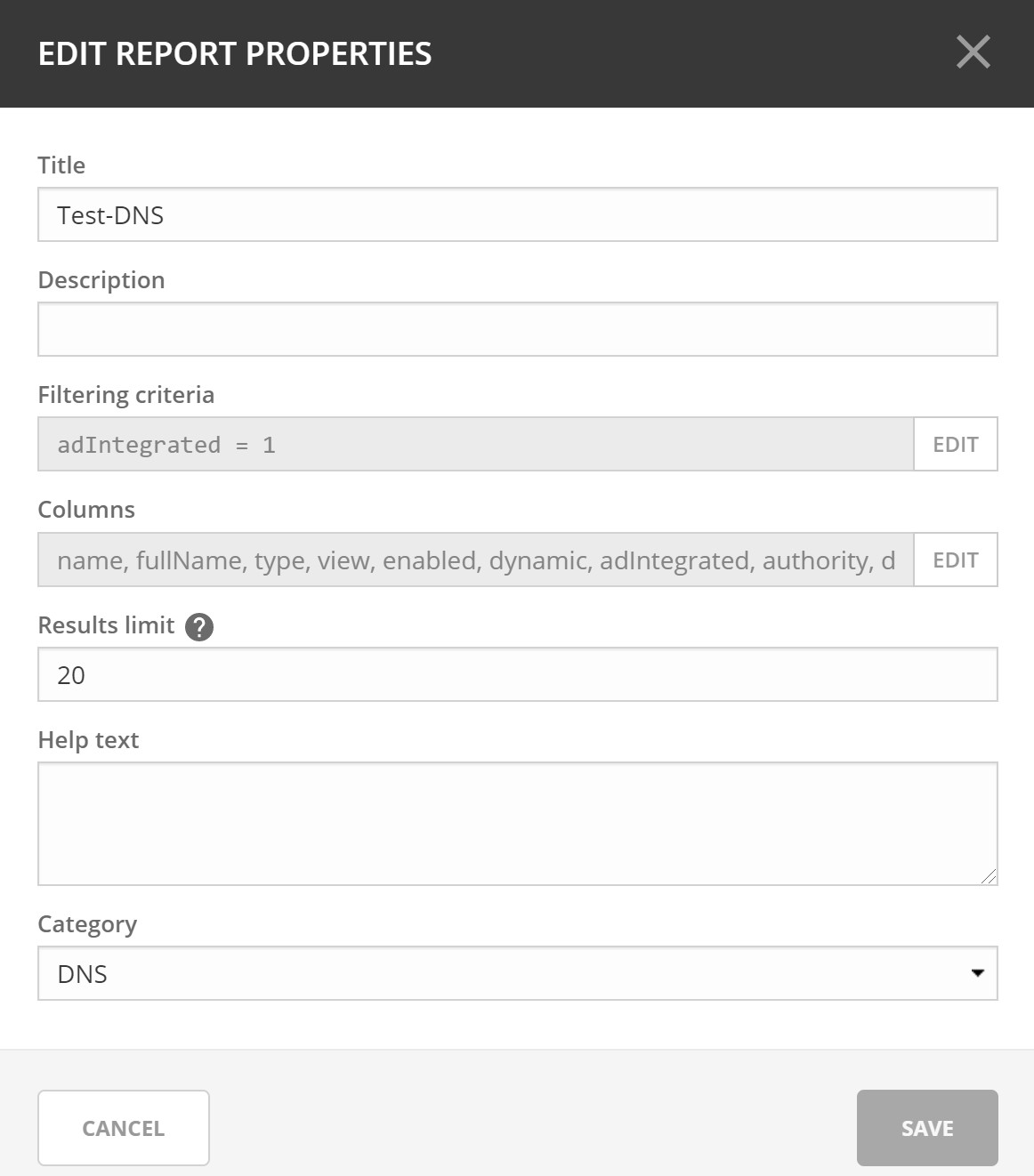Reports Management
Introduction
Micetro manages vast amounts of DNS, DHCP, and IPAM data. Building reports is easy and can be tailor-made by correlating related data in a few steps, and scheduling the results to be generated daily, weekly or on a custom schedule. There are built-in report definitions that can be used as a reference to build reports. Using custom fields in Micetro further enhances reports by correlating custom fields with the built-in ones. The system then allows you to create reporting definitions that can be run either one time only, or scheduled to run later or at regular intervals.
The reports can be viewed within the Web Application, or downloaded in various formats for further analysis.
When the Reports page is opened, you are presented with a list of report definitions. Like every other part of the Web Application, this list can be filtered and searched.
Reporting Module
You can:
create and save new report definitions
schedule reports to be generated
run reports
download reports in various formats
Viewing the Report Definition List
A report definition is a recipe for the actual report. It contains the filter criteria used to build the report, along with scheduling information, and other properties.
The list of report definitions is shown when first opening the Reports page.

For help with finding and organizing the reports, use the filtering sidebar on the left-hand side.
All Definitions |
Shows all report definitions. |
Favorites |
Shows report definitions that have been added to favorites. See Adding a Report Definition to Favorites. |
Categories |
Shows all report definitions that belong to a specific category. |
Creating a New Report
A new report definition can be created by clicking on the Create button above the report list, or by selecting the Create new report in the action list in the Inspector.
With the wizard, you can:
change the report definition’s source
edit its filter
select the columns to be included in the output
and then run the report.
Additionally, it is possible to schedule a report to be generated at specific times or intervals.
After running the report, you are presented with a preview of the results and has the option of saving a copy of the report in a number of different formats. See Viewing the Report Results.
A description of each report source is described in Report Sources.
Step 1: Select Source
Select one of the existing reports or a data source as the basis of the new report definition.

Step 2: Edit Filtering Criteria
In the second step, you have the option of editing the filtering criteria. You might want to make some adjustments to the fields in the filter of the selected report definition, for example, extending a time span or selecting a different username. It is also possible to change the filter completely and create a new report definition.

Conditions and Parenthesis
Operator |
Description |
|---|---|
And |
All the conditions have to be met |
Or |
Sufficient that any of the conditions are met |
It is possible to add parenthesis to create sub-conditions with a different operator. The report definition shown in the screenshot above can be read as follows:
“Last seen must be less than one month ago, lost must be true and either claimed or usage must be true”.
This translates into: “Show me hosts that have not answered during discovery in the last month that are either claimed or in use.”
Comparison Operator
Depending on the type of field, you are presented with different comparison operators.
String |
Number, timespan, date |
Boolean, pick-list, object |
|---|---|---|
equals |
= |
is |
doesn’t equal |
!= |
is not |
contains |
< |
|
doesn’t contain |
> |
|
starts with |
<= |
|
doesn’t start with |
>= |
|
ends with |
||
doesn’t end with |
||
matches regex |
||
doesn’t match regex |
Step 3: Select Columns
It is possible to select which columns are to be included in the report result.

Note
By default, all available columns are selected.
Step 4: Save or Run Report Definition
By selecting Run once and discard definition changes, the report definition will not be saved, and you will be presented with a dialog that shows the report results.
By selecting Open scheduling dialog after saving, you can schedule periodic executions of the report.
Click Finish to run the report and get the results.
Step 5: Schedule

In this step, report generation can be scheduled to run periodically. The frequency and the interval can be specified, and a start date can be set.
For more information, see Schedule Regular Report Generation.
Step 6: Run the Report Definition
After the report has been created, it can be generated at any time by selecting the report definition in the list, and then clicking the Run report task. (See Viewing the Report Results.)
Viewing the Report Results
Viewing the List of Reports
To view a list of all reports that have been generated for a particular reporting definition, double click the reporting definition in the list.
This lists all reports along with how much data is in the report (row count), and how long it took to generate the report (duration).
Double clicking on a report in this list allows you to preview a report.
Previewing and Downloading a Report
Previewing the report results can be done in various ways:
Generating the report instead of saving it after going through the create report wizard.
Selecting a report definition in the list and clicking the Run report task.
Preview a report result from a scheduled run:
Select a report definition in the list.
Find the “Reports” inspector item.
Find a scheduled run of a report and click on the timestamp or the ellipsis, and then select Preview on the menu.
Note
The preview only shows up to the first 150 rows in the report. For the full report it needs to be downloaded.

In all cases, you will be presented with a preview of the report in a separate dialog box. (As shown above.)
The results can then be downloaded by clicking the download button. The drop-down menu offers a number of file formats to select from (ie. CSV, XML, JSON or SYLK).
Tip
Sylk and CSV are handy for importing the data into a spreadsheet application for further processing.
Actions for Reports
In the actions part of the Inspector, the available actions for each selected reports are shown.
Note
In the case of the reporting module not being enabled, the unavailable actions are greyed out.
Run now
Select a report definition in the list, and then click the Run now action.
A dialog box is displayed showing a preview of the report results. (See Viewing the Report Results.)
Schedule Regular Report Generation
In this dialog box a report can be scheduled to be generated at specific intervals. Additionally, it is also possible to specify a path to a script that will be run after the report is generated and also can scavenging be scheduled.
Select a report definition in the list, and then click Schedule.
The following dialog box is shown where scheduling and scavenging can be configured.

Settings for Schedule.
Enabled |
When selected, scheduling is enabled for this report |
Frequency |
Specifies the frequency in which the report is scheduled to run. |
Every |
Specifies the interval in which the report is scheduled to run. |
Starts on |
Specifies the starting date for the report to be run on. |
By selecting for example ‘2’ and ‘Weeks’, a new report is generated at the selected start on date/time and then at every 2 weeks afterward.
Note
All dates and times are according to the time zone setting on the Men&Mice Central server.
Settings for Scavenging
Maximum number of reports to keep |
Specifies how many reports will be retained in the system. This helps with making sure that disk space does not run out in case many large reports are generated in a small time interval. |
Maximum number of days to keep results |
Specifies for how many days the reoprts will be retained in the system. This helps with making sure that disk space does not run out in case many large reports are generated in a small time interval. |
Duplicate an Existing Report Definition
Use this option to create a new report definition based on an existing one.
Select a report definition in the list, and then click Duplicate.
The create new report wizard will be shown, and you will be allowed to edit the filtering criteria for the new report. (As described in Step 2 in Creating a new report.)
Delete a Report Definition
Select a user defined report definition in the list, and then click Delete.
A dialog box is presented prompting you if you want to delete the report definition.
Edit Report Definition Properties
Both the report definition properties, the filtering criteria for the report, and the data columns for the report results can be edited.
Note
Only user created report definitions can be edited.
Select a report definition in the list, and then click Edit report properties.
A dialog box is presented which allows for specifying the properties for the report, along with editing the filtering criteria.

Clicking Edit for the filtering criteria brings up the following dialog box:

Scavenge Reports
Report results take up disk space on the Men&Mice Central server. The system allows for specifying the maximum number of reports (or the maximum number of days to keep each result) for each report definition. Oldest results are deleted when the limit is reached.
Select a report definition in the list, and then click Scavenge reports.
A dialog box is presented which allows for specifying the properties for scavenging reports.
Adding a Report Definition to Favorites
Select a report in the list, and then click Delete.
Click on the star button to the left of the Quick filter field:

Report Sources
There are 24 reports definitions in the list on the Reports page (not counting user defined reports).
12 base report definition sources: sources that either allow you to query one particular object type in the system (for example Activity); or sources that give access to a particular data relation in the system (e.g. Host discovery).
12 derivatives of the base report sources showing the specification possibilities they offer. (Zone creation/deletion building upon Activity and IP reconciliation building upon Host discovery.)
Filter Field Types
String, number |
Free text input. |
Date and time |
Date time string or current time delta shorthand units, e.g. -2w, +1d. |
Timespan |
Timespan shorthand units, e.g. 24h, 2d, 30m |
Object, boolean, options |
A dropdown is presented with the available options. |
Timespan Formats
<num><time unit>
<time unit> ::= s (seconds), m (minutes), h (hours), d (days), w (weeks), M (months), y (years)
Date Time Formats
General date time format consist of date and/or time (separated by a space).
<datetime> ::= <date> <time>
<time> ::= HH:MM[:SS[:TTT]][ AM|PM]
<date> ::= [yy]yy-mm-dd
| dd.mm.yy[yy]
| mm/dd/yy[yy]
Timestamps formatted according to RFC3339.
YYYY-MM-DDTHH:MM:SS[time-secfrac][time-offset]
Current time deltas, i.e. a date time relative from now, can also be used.
-|+ <num><time unit>
<time unit> ::= s (seconds), m (minutes), h (hours), d (days), w (weeks), M (months), y (years)
To include more than one value for a particular field the field has to be added again to the filter with an “OR” condition. (For example: the Address records, where the record type field has to be either A or AAAA.)
